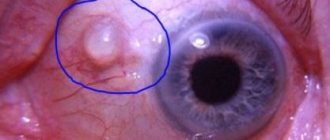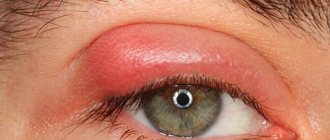The appearance of a lump in the groin in men always indicates one or another pathology of varying severity. The compaction can be located either directly under the skin or in the deep layers of tissue, accompanied by painful sensations or not causing any discomfort at all. In any case, the cause of this condition must be clarified.
Causes of groin lumps in men
Among the most common causes of lumps in the groin area are the following pathologies:
- Hernia . Protrusion of hernial contents occurs due to weakening of tissues and muscles. This pathology can develop under the influence of various factors - ascites, a sharp increase in body weight, chronic hysterical cough, consequences of injuries or operations, etc. If symptoms such as severe abdominal pain, cold sweat, nausea indicate that the patient may need emergency surgical care (if a hernia is strangulated).
- Inguinal lymphadenitis. Often it is a sign of a disease accompanied by inflammation and often of an infectious nature (orchitis, genitourinary tuberculosis, prostatitis, etc.).
- Vascular pathology. For example, with varicose veins of the small pelvis, protrusion of a vessel in the groin area may occur. People with congenital characteristics, overweight, heavy lifters, and connective tissue pathologies are prone to this disease. Also, varicose veins can develop due to stagnation of blood in the pelvis as a result of adynamia (an almost immobile lifestyle), irregular sex life, and frequent constipation.
- Cryptorchidism (undescended testicle). A variant of the norm is this phenomenon in newborn boys. Cryptorchidism may resolve on its own within a few weeks after birth.
- Inguinal abscess. It is characterized by redness of the skin in a certain area, painful lumps, and increased temperature. This indicates that a cavity with purulent contents has formed. Typically, pathology develops due to damage to the integrity of tissues, followed by the formation of a boil. As you can see, bumps in the groin area can occur for various reasons. A qualified doctor can find out what the problem is and what caused it.
Bartholin gland abscess - symptoms and treatment
Treatment for a Bartholin gland abscess is always surgical . Sometimes surgery is combined with drug therapy (broad-spectrum antibiotics, antimicrobial and anti-inflammatory drugs) and physiotherapeutic treatments that prevent relapses and improve immunity.
It is believed that if the patient does not have signs of a systemic inflammatory reaction (sepsis), cellulitis, multiple abscesses, or immunosuppression, then there is no need for antibiotics. In the presence of the above pathologies, while waiting for the results of bacteriological culture, therapy with a broad-spectrum antibiotic active against several pathogens is prescribed.
Treatment of false abscess is carried out on an outpatient basis or in a hospital with a day stay. Therapy for a true abscess requires only hospital treatment [7][12].
Types of surgical treatment of Bartholin gland abscess.
Excision and drainage of the abscess. An incision is made into the abscess capsule with a surgical scalpel, and the contents of the abscess are removed with a syringe. Then the abscess cavity is washed with antiseptics and a rubber drainage is installed. Subsequently, the gland cavity is treated daily with antiseptics, the drainage is changed, and sterile dressings with antibacterial ointment or antimicrobial gel are used.
Opening the abscess and forming a new opening of the Bartholin gland duct. To prevent the abscess from reoccurring, a new opening of the Bartholin gland duct is formed. To do this, perform one of the following operations:
- Laser treatment (vaporization) for false abscesses. The abscess is removed without traumatizing healthy tissue using a laser beam. The method is non-contact, does not cause bleeding or scars, and promotes rapid restoration of tissue and functions of the gland. The operation is performed on an outpatient basis [15].
- Installation of a Word catheter - a small inflatable balloon with saline solution. The catheter is in the cavity of the Bartholin gland for 4-6 weeks, by which time the Bartholin gland duct should have formed. The method is used after inflammation has resolved [11].
- Marsupialization - the edges of the wall of the cavity of the Bartholin gland are sutured to the border of the surgical wound to form an artificial opening of the duct and left open until healing.
Opening an abscess using the radio wave method is painless , does not leave a burn, and after treatment, no scars. A small incision is made, there is no bleeding during the operation, and the tissue is quickly restored [15].
Puncture aspiration is the removal of the contents of an abscess using a puncture . It is carried out when a disease is detected in pregnant women.
Removal of the Bartholin gland is indicated for suspected malignant process (lumpy surface of the abscess capsule), for swelling that does not go away after surgical treatment for more than a month, for relapses of the disease more than twice. In case of true or recurrent abscesses of the Bartholin gland, the formation is removed along with the gland. The procedure can cause complications such as the formation of fistulas between the rectum and vagina, sepsis and bleeding. When the Bartholin gland is removed, the paraurethral glands take over the function of moisturizing the labia [7].
Small abscesses can regress without treatment, maturing and opening on their own. Elevation of the lower extremities, local procedures using ozonated saline and ultrasonic cavitation with antiseptic solutions will help speed up the resolution of inflammation.
After surgery, physiotherapeutic treatment - magnetic therapy, irradiation of blood with infrared laser (ILBI) or ultraviolet light (UFO), treatment and restoration of the acidic environment of the vagina with antiseptic solutions using ultrasonic cavitation [7][12][14].
Treatment of a lump in the groin of a man
Doctors carry out therapy, the main goal of which is to eliminate the pathogenetic factor. If necessary, the patient is hospitalized, conservative (drug) therapy is used, or surgery is performed (as indicated).
If you find a lump in your groin, you should not delay visiting a doctor. Most problems can be successfully treated. The medical office is attended by qualified, experienced doctors who prescribe only the necessary diagnostic tests and, based on their results, develop an individual effective treatment plan.
Urologist in Lipetsk: +7 (4742) 90-40-50, and you can also make an appointment online
Therapy for regional lymphadenitis
The danger of regional enlargement of nodes is in the absence of obvious pain in the groin. In 80% of cases, there is an enlargement of the lymph nodes without pain. This complicates diagnosis and leads to unintentional delayed treatment. While early detection of diseases that provoke lymphadenitis in the groin significantly increases the chances of treatment without complications.
Enlarged lymph nodes in the groin are treated only comprehensively. Initially, it is necessary to determine the source of the problem - the area of localization of inflammation. Without this (getting rid of the primary disease), treatment of the lymph nodes in the groin will be accompanied by relapses.
Much depends on the degree of increase and form of infection. For non-purulent forms of diseases in the groin, pharmacological therapy (antibiotic ointments/gels or oral administration) in combination with restriction of mobility may be sufficient. If suppuration begins against the background of enlarged lymph nodes, a surgical procedure may be required - opening and cleaning the lesions in the groin.
In some cases, medication and physical therapy for enlarged inguinal lymph nodes may be accompanied by the use of herbal-based drugs (dandelion, peppermint, herbs) in order to enhance the sedative effect in the inguinal lymph nodes.
Team of Doctors
It is worth noting that the risk of recurrent hernia rarely exceeds 5-10%. Most often, the recurrence of pathology occurs due to ignoring or negligent implementation of medical recommendations. It is extremely rare that it is provoked by technical errors in the operation or untreated chronic diseases of the patient.
Symptoms of recurrent inguinal hernia:
- hematomas that do not resolve;
- suppuration of the suture or wound area;
- recurrence of constipation, diarrhea with blood discharge;
- persistent cough;
- protrusion of the peritoneum and internal organs (looks like a spherical swelling).
Treatment
Pre-hospital assistance
Avoiding uncomfortable underwear and intimate hygiene products that irritate the skin and mucous membranes can help reduce swelling of the vulva. Regular hygiene procedures are necessary. For inflammatory processes, baths with herbal decoctions and antiseptic solutions are indicated. In case of intense pain, a single dose of an analgesic is acceptable. Increasing swelling, foul-smelling or bloody discharge, severe pain, and general health problems are reasons to immediately contact a gynecologist.
Conservative therapy
The treatment plan is drawn up individually after determining the cause of swelling and a comprehensive assessment of the condition of the reproductive organs. Etiopathogenetic and symptomatic agents are used. Drug therapy is supplemented with physiotherapeutic procedures and local techniques. For STIs, medications are prescribed to both sexual partners at the same time. The following groups of drugs are used:
- Antimicrobial
. Depending on the pathogen identified, antibiotics, antimycotic, anthelmintic or antiprotozoal medications are prescribed. - Antihistamines
. Indicated for allergic reactions, severe itching. Helps reduce inflammation and alleviate the patient's condition. - Hormonal
. Local treatment with hormonal ointments is carried out for kraurosis of the vulva, atrophic vulvitis in premenopausal women. - Local action
. Taking into account the etiology of the disease, intravaginal suppositories, tablets, suspensions with antimycotics and antibiotics can be used. To restore the vaginal microflora, suppositories with acidophilus bacteria are recommended.
Patients with acute vulvitis are prescribed SMT, UHF, and ultraviolet radiation. For chronic inflammation, mud applications, ozokerite, paraffin, and infrared laser treatment are effective. Women with vulvar cancer undergo chemotherapy and photodynamic therapy.
Diagnosis of pain in the leg closer to the groin
Joint pain cannot be ignored. Any unpleasant sensations indicate a violation of the functionality of the body and pathology of the internal organs. Contact KDS Clinic. Experienced specialists will provide assistance at any time. The patient is sent for tests and a comprehensive examination of the body. With such symptoms, the patient should undergo an X-ray of the joints and ultrasound diagnostics. General tests will show details of the body's internal indicators. To get a more accurate result, it is worth doing magnetic resonance imaging. The procedure is prohibited for pregnant women, women during the lactation period and children under sixteen years of age. Consult your doctor before undergoing the examination.
Make an appointment with a specialist by number. In some cases, the patient is left in the hospital to monitor improvements in indicators. We suggest that you familiarize yourself with prices for all services on the official website of the medical institution.
Right-sided inguinal hernia: diagnosis
An inguinal hernia falls under the category of diseases of the digestive organs and has a code according to ICD 10 (the international classification of diseases in the 10th edition). Pathology is diagnosed in several stages. At the initial stage, the patient visits a surgeon who examines his complaints, conducts a visual examination and palpates the groin area. During the examination, the size of the hernial bulge, its shape and other features are determined. The doctor does a cough test (asks the patient to cough) as well as a straining test to evaluate the symptoms of a cough. If pain occurs when straining or coughing, this may indicate the presence of inflammatory processes in the abdominal cavity.
To recognize the structure of the tissues of the hernial sac, an ultrasound examination of the canals, areas of the scrotum, pelvic organs, and peritoneum is performed. This study helps determine the hernial content of the bulge and the condition of the inguinal canal. Examination of the patient using X-rays, which involves the introduction of a contrast agent, allows you to obtain comprehensive information about the characteristics of the hernia. A blood test makes it possible to determine the presence of suppuration caused by pathology.
A right-sided inguinal hernia in men cannot be treated in any way other than surgery. To get rid of this anomaly, you will have to consult a surgeon. But in some cases, such a radical method of therapy is contraindicated. For example, if the patient is very old or extremely exhausted.










